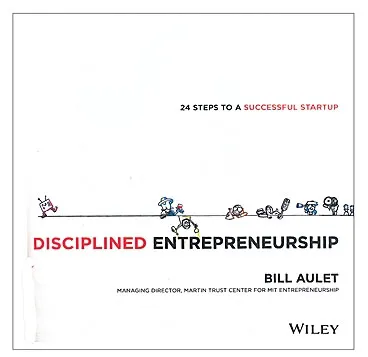[Book Review] Disciplined Entrepreneurship: 24 Steps to a Successful Startup

Many believe that entrepreneurship cannot be taught, but it is possible to teach people how to make great products and thus create a successful startup, as clearly illustrated in the insightful and actionable guidebook, ‘Disciplined Entrepreneurship.’
Bill Aulet is the managing director in the Martin Trust Centre for Entrepreneurship at MIT and also a senior lecturer at the MIT Sloan School of Management. He has launched initiatives like the MIT Clean Energy Prize, Energy Ventures Class, Regional Entrepreneurship Acceleration Program (REAP), “t=0” Entrepreneurship Festival, Beehive Cooperative, Entrepreneurs Walk of Fame, Corporate Innovators Sponsor Group, and Global Founders' Skills Accelerator.
Bill has had a 25-year track record of success in business himself. He has directly raised more than $100 million in funding for his companies and led to the creation of millions of dollars in market value in those companies.
Many of the case studies in the book feature the company he founded, SensAble Technologies. The other case profiles in the book are from Aulet’s course, with startups in sectors such as footwear, water filtration, furniture shopping, baseball fantasy games, wind turbines, bio-sensors, landfill technologies, silent alarm clocks, arts education, skin care, digital marketing, and e-commerce for handicrafts.
The book also has a companion Web site (http://disciplinedentrepreneurship.com/) with case studies and other resources. Entrepreneurship is a team sport which can be taught and should be considered a legitimate profession and discipline, according to Aulet.
The book covers many iterative loops along the startup roadmap, and the steps are illustrated by Marius Ursache. It is not knowledge that sets you free, but action, Aulet explains. To begin with, entrepreneurs must have an idea, a passion, and preferably a tech breakthrough.
One chapter is devoted to each of 24 steps in the startup toolbox, and I have summarised them briefly in Table 1 according to six themes; each chapter makes for a superb read and is backed with references and resources.
Table 1: Steps to a Successful Startup
Aulet distinguishes between SME entrepreneurship (more focused on non-tradeable jobs such as running a restaurant, with linear growth rates) and innovation-driven entrepreneurship (with investments, more risk, and potential of global exponential growth and profits).
He also highlights the unique nature of ‘two-sided’ markets which need two kinds of communities to succeed, for example buyers and sellers (e-Bay) or readers and advertisers (AdWords). This calls for multiple total addressable market (TAM) calculations and persona descriptions for each.
“Beachhead TAM calculation is your sanity check that you are headed in the right direction,” Aulet flags off in the beginning. It is a combination of customer base and estimated product price. Value proposition itself is a combination of how the product makes life better, faster, cheaper or less risky for the customer.
Entrepreneurs should stay out of the ‘reality distortion zone’ and not fall victim to their hope and hype; dealing with customer feedback – even from naysayers – will help focus on real solutions, Aulet advises.
‘Core’ aspects of the startup would be unique features such as network effects, outstanding customer service, lowest cost or best user experience. This will then need to be backed up with business models such as up-front charge, hourly rates, subscription, license, ad support, reselling of analytics, transaction fees, tiered models, shared savings and franchise.
Pricing should be flexible for a range of customers, example for early testers, lighthouse customers and co-creators. Lifetime value calculations are important to gauge the long-term viability of current and future products, and go hand in hand with calculation of customer acquisition costs.
Once a product has been launched, the startup founder then needs to address the challenges of building company culture for the long term, HR strategies, cash flow skills, and corporate governance.
“The world needs more and better entrepreneurs because our world’s problems are becoming more dire, complex and ubiquitous,” Aulet concludes.
The book has a number of witty and inspiring quotes, and it would be nice to end this review with some of them.
“Entrepreneurship is not only a mindset but a skillset.” – Mitch Kapor, Founder, Lotus
“While the spirit of entrepreneurship is often about serendipity, the execution is not.” - Joi Ito, Director, MIT Media Lab
“Ideas are a dime a dozen but great entrepreneurs are what create value.” – Paul Maeder, National VC Association
[Follow YourStory's research director Madanmohan Rao on Twitter at http://twitter.com/MadanRao]


![[Book Review] Disciplined Entrepreneurship: 24 Steps to a Successful Startup](https://images.yourstory.com/cs/wordpress/2013/12/discipline.jpg?mode=crop&crop=faces&ar=16%3A9&format=auto&w=1920&q=75)




